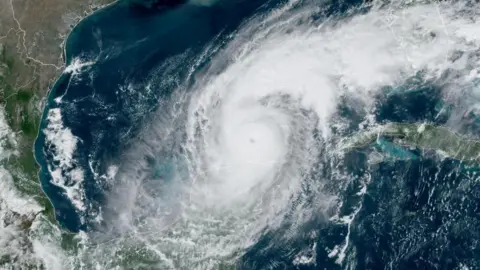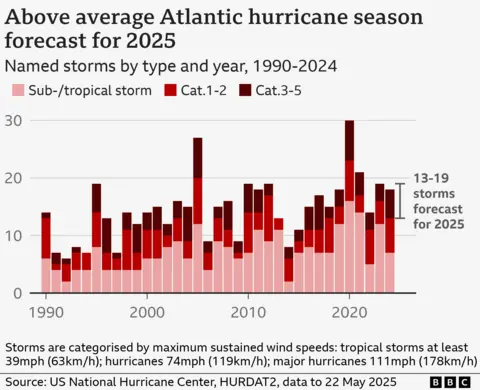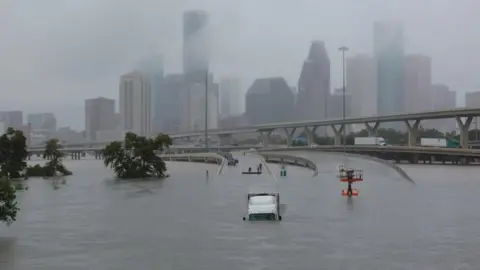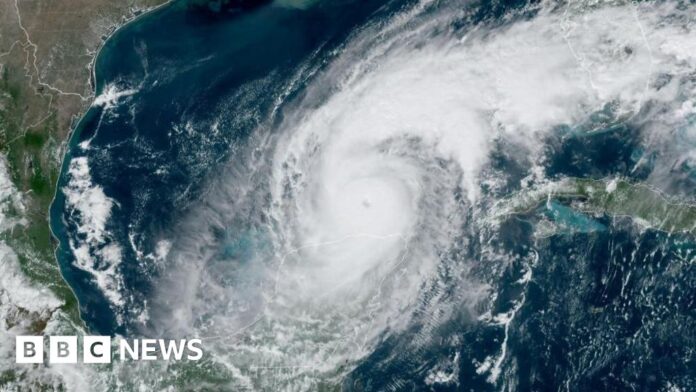Climate reporter, BBC News
 Noaa/Reuters
Noaa/ReutersThe coming Atlantic hurricane season is expected to be busier than usual, US science agency NOAA has warned, just as cuts to American research are raising fears about the ability to track and prepare for these often deadly storms.
Between six and 10 hurricanes are forecast for the Atlantic between June and November, compared with the typical seven.
Warmer sea temperatures – made more likely by climate change – and generally favourable atmospheric conditions, are behind the forecast.
Several scientists have told the BBC that widespread firings by President Donald Trump’s administration of government researchers could endanger efforts to monitor hurricanes and predict where they might hit.
Today’s 2025 Atlantic season outlook covers the Atlantic Ocean, Caribbean Sea and Gulf of Mexico, called the Gulf of America by the Trump administration.
In total NOAA expects between 13 and 19 named tropical storms. Of these, between six and 10 could become hurricanes, including three to five major ones – meaning they reach category three or above (111mph or 178km/h).
That’s not as many as last year’s very active season, which saw 18 tropical storms including 11 hurricanes of which five were major hurricanes.
But it’s more than the long-term average of 14 named tropical storms a year, of which seven are usually hurricanes, with three major ones among them.

Climate change is not expected to increase the number of these storms globally. But a warming planet is thought to increase the chances of them reaching the highest wind speeds, bringing heavier rainfall and a higher likelihood of coastal flooding.
This year’s above average forecast is expected for two main reasons.
Firstly, sea surface temperatures are above average across most of the tropical Atlantic, although they are not as extreme as this time last year.
Warmer seas provide the fuel source for hurricane growth as they track westwards across the Atlantic.
Secondly, the natural weather pattern known as El Niño – which makes it harder for Atlantic hurricanes to develop – is not expected this year, according to NOAA.
Neutral or weak La Niña conditions – which favour Atlantic hurricanes – are considered more likely, though this early on it is difficult to say.
Other conditions have to be right for hurricanes to develop, and those aren’t possible to predict months in advance.
Localised air movements and even the amount of dust in the atmosphere can play important roles in shaping whether these storms develop or not.
“We can’t really predict all that stuff this far out,” said Phil Klotzbach, research scientist at Colorado State University, which has also predicted an above-average season.
‘Less data means a worse forecast’
But NOAA’s pre-season forecast is still giving scientists cause for concern – and not just because of the meteorological backdrop.
Since the beginning of President Trump’s second term, hundreds of NOAA staff have been laid off, with the aim of cutting US government spending and costs to the taxpayer.
This has left the National Weather Service – NOAA’s weather forecasting and hazard-warning branch – critically understaffed ahead of the hurricane season, several scientists told the BBC.
“I know that the people remaining are trying their absolute hardest to provide accurate forecasts, but when you’re reduced to such few staff, it’s going to lead to burnout,” said Zack Labe, a climate scientist who was recently laid off by NOAA.
The office in Houston for example – Texas is particularly vulnerable to hurricanes – is effectively without its top three management positions.
Other offices are struggling to maintain 24/7 operations. Experts with contacts at NOAA told the BBC of battles to get basic maintenance over the line, from computer systems to toilets.
US media widely reported last week that the National Weather Service was seeking to fill more than 150 key vacancies – from other positions within NOAA due to a ban on hiring new staff – ahead of the hurricane season.
BBC News has been unable to independently verify these reports, and has reached out to NOAA and the White House. Neither have responded to requests for comment.
“It’s a huge problem, and it is a growing problem, and it is a problem that will likely, unless it is immediately resolved, become life threatening during severe weather events,” said Daniel Swain, a climate scientist at the University of California, Los Angeles.
He said he feared the cuts so far were just “the tip of the iceberg”.
Staffing cuts could also threaten “hurricane hunter” flights – plane journeys into the storms as they approach land to inform preparations for landfall.
And scientists have spoken of other reductions in atmospheric observations, such as weather balloon launches, with the Trump administration reportedly attempting to cut anything related to “climate”.
 Reuters
ReutersHurricane forecasts have generally become more accurate over time, but there are fears that these cuts could put that progress at risk.
“Less data means a worse forecast,” warned Matt Lanza, a Houston-based meteorologist.
“I’m especially concerned about hurricane season because a lot of the steering mechanisms that direct hurricanes are governed by what’s happening thousands of feet up,” he added.
“And if we’re not collecting data in important places, then I think that risks your hurricane forecast suffering.”
It’s difficult to say whether this will become apparent this year – a lot will depend on exactly where and when hurricanes hit.
But it also has potential implications for weather forecasting further afield in the world, which the Trump administration argues has become too reliant on the US.
“You need good information on the state of the atmosphere and the oceans from the whole world to make weather forecasts for any given location on Earth,” warned Dr Swain.
“The impacts [of cuts to NOAA] are most concentrated in the United States, but will eventually cascade beyond the US should they continue at their current level or further expand.”
In a press conference, NOAA acting administrator Laura Grimm said that NOAA had the best scientists and continued to make advances in forecasting, and remained committed to protecting the public.
Additional reporting by Phil Leake





